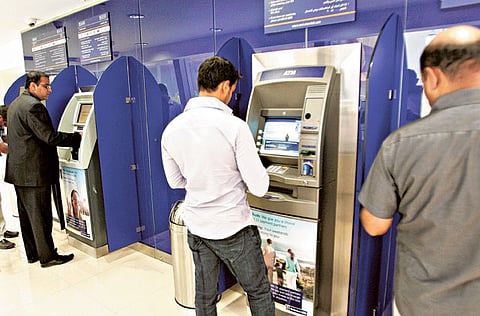Central bank stress test shows UAE banking sector remains solid
Adequate capital buffers and liquidity keep banks strong against shocks

Dubai: The UAE banking system remains resilient despite challenging operating environment from the repercussions of the COVID-19 pandemic, according to results of the latest Financial Stability Report (FSR) of the Central Bank of UAE.
Core banking indicators pointed towards adequate funding and liquidity positions and sustained lending capacity. However, vulnerability of the banking sector remained as the economic slowdown weighed on asset quality.
The surge in impairment charges and lower operating income reduced profitability. However, aggregate capital buffers remained adequate and well above regulatory requirements.
Strong fundamentals
The UAE banking system entered the pandemic from a strong position, enabling banks to provide targeted relief measures to affected clients.
“Financial soundness indicators reflected the overall resilient position of the UAE banking system, underpinned by adequate capital and liquidity buffers, which were sustained during the pandemic. Nevertheless, uncertainty remains with regards to the pace of the economic recovery and related asset quality pressures,” said the FSR.
The UAE banking system assets expanded 3.4 per cent in 2020, to Dh3.2 trillion. Aggregate loan growth remained positive in 2020 at 1.2 per cent year-on-year, despite the economic contraction. The lending growth moderated at yearend due to loan portfolio rebalancing and corporaten loan repayments.
UAE banks’ funding profile continued to be conventional, primarily through deposits accounting for 68.6 per cent of total liabilities. The deposit base of the UAE banks was mainly composed of resident deposits denominated in the local currency.
Reliance on interbank funding remained low, accounting for 5.4 per cent of total liabilities. Further, on aggregate, the UAE banking system remained a net lender in the non-resident interbank market
Asset quality risks
The economic contraction during the pandemic has had an impact on the pace of growth in the overall non- performing loans (NPL). The higher headline NPL ratios in the UAE were also affected by legacy non-performing loans that were already provisioned and the restructuring of few large borrowers during the year. Consequently, the Net NPL ratio and NPL ratio increased to 3.5 per cent and 8.1 per cent year on year by the end of 2020.
“While the asset quality pressures due to the global pandemic remained, the likely economic recovery is expected to gradually alleviate credit quality concerns albeit with a lagged effect,” the FSB report noted.
Forward-looking loan loss provision increased in 2020 amid the sharp contraction in economic activity. On aggregate, total provisions increased 18.4 per cent year-on-year. Out of the total increase in provisions, specific provisions grew 18.2 per cent while general provisions by 19 per cent year-on-year.
Solvency stress test
The CBUAE said in 2020 bottom-up stress test was postponed to 2021 to ease the operational burden of the UAE banks. Instead, the CBUAE conducted frequent top-down solvency and liquidity stress tests by using a number of hypothetical adverse scenarios at different stages of the COVID-19 crisis.
Solvency stress tests combine impacts of the baseline and adverse scenarios on banks’ balance sheets and income statements, focusing on projected capital adequacy.
In the latest top-down solvency stress test, banks remained adequately capitalised with the average CET-1 ratio above 14.4 per cent under the baseline scenario. Average banking system CET-1 ratio fell by 243 bps from 14 per cent to a trough of 11.6 per cent in 2021 under the adverse scenario.
Sensitivity test
The CBUAE conducted quarterly sensitivity stress tests based on its analysis of the most vulnerable economic sectors under the COVID-19 pandemic.
Based on international evidence and UAE data analysis, hospitality, wholesale and retail trade, transport and storage, and construction sectors were identified as the most vulnerable. Under the most severe assumptions, 50 per cent additional stress was applied to the risk parameters of the worst historical values for the vulnerable sectors. The results showed that significant share of credit risk losses was attributed to the vulnerable sectors hypothetical adverse scenario.
Liquidity stress test
The UAE banking system continued to have adequate levels of liquid assets and a stable deposit base during the year. Strong liquidity buffers enabled banks to accommodate drawdowns when businesses relied heavily on banks’ funding as the COVID-19 shock hit.
In response to the stress situation arising from the pandemic, CBUAE took action to maintain financial stability through the TESS [Targeted Economic Support Scheme]. It provided the banks liquidity at a scale which was necessary and effective in supporting market functioning.
The CBUAE uses liquidity stress tests to assess the resilience of the banking sector to liquidity shocks. Liquidity stress tests were performed monthly as one of the heightened risk monitoring measures taken by the CBUAE to ensure that liquidity risks could be detected early and promptly addressed.
The latest liquidity stress testing results showed that banking system has the capacity to withstand sudden shifts in deposit base without encountering liquidity challenges. However, some banks relying on wholesale funding and having higher depositor concentration would be more vulnerable under stress conditions.
Sign up for the Daily Briefing
Get the latest news and updates straight to your inbox









